Elder D. Todd Christofferson of the Quorum of the Twelve Apostles of The Church of Jesus Christ of Latter-day Saints will dedicate the Salta Argentina Temple on Sunday, June 16, 2024. Having served as a full-time missionary in northern Argentina, his return is a joyous opportunity to reflect on his own service as well as the growth of the Church in South America.
The Salta temple will be the third operating house of the Lord in Argentina and is one of seven dedicated, announced or under construction in the nation. As a missionary, Elder Christofferson was in Salta for the dedication of the Church’s first meetinghouse there; he returns this month for the dedication of the new house of the Lord in Salta.
Elder Christofferson joins this episode of the Church News podcast to reflect on his mission and Argentina. He is joined by guest host Church News managing editor Scott Taylor, who leads the conversation on service and growth in the nation. Elder Christofferson concludes with podcast sharing his testimony in both English and Spanish.
Listen to the Church News podcast on Apple Podcasts, Amazon, Spotify, YouTube or wherever you get podcasts.
Transcript:
Elder D. Todd Christofferson: One thing I would say is don’t ever be discouraged. You don’t see things unfolding that are unfolding. You don’t see what the Lord is putting in place. The Argentina North Mission was about half the country. I thought when I left, “I have done something worthwhile and probably will never see this place again.” But now, I think of coming back these years later, having been at the dedication of the first chapel, now to be there for the dedication of the temple. To see that transition and the progress of the Lord’s kingdom, all day-to-day invisible to us. And we don’t see what is happening, but looking back see a tremendous miracle has occurred. And it just says to me, again, it is the Lord’s work. He is making it happen. He is doing the work for the most part. We get to help around the edges.
1:11
Sarah Jane Weaver: This is Sarah Jane Weaver, executive editor of the Church News, welcoming you to the Church News podcast. We are taking you on a journey of connection as we discuss news and events of The Church of Jesus Christ of Latter-day Saints.
Elder D. Todd Christofferson of the Quorum of the Twelve Apostles will dedicate the Salta Argentina Temple on Sunday, June 16, 2024. Having served as a full-time missionary in Argentina, his return is a joyous opportunity to reflect on his own service as well as the growth of The Church of Jesus Christ of Latter-day Saints in the nation. The Salta temple will be the third operating house of the Lord in Argentina and is one of seven dedicated, announced or under construction in the South American nation.
Elder Christofferson joins this episode of the Church News podcast to reflect on his mission and on Argentina. He is joined by guest host Church News managing editor Scott Taylor, who leads the conversation on service and growth in the nation.
2:14
Scott Taylor: Elder D. Todd Christofferson of the Quorum of the Twelve Apostles has welcomed us today in his office here in the Church Administration Building. Thank you for having us here, and thank you for joining us for the Church News podcast.
Elder D. Todd Christofferson: My pleasure. Thank you.
Scott Taylor: On Sunday, June 16, you will be dedicating the Salta Argentina Temple, which becomes the third operating house of the Lord in Argentina and one of seven total temples in that southern South America country that are dedicated, under construction or announced. And Argentina is a country that you love and have visited numerous times.
Elder D. Todd Christofferson: Near and dear to me, yes.
2:51
Scott Taylor: And we’ll talk about how it’s near and dear to you today. The first time as a young full-time missionary, and then a number of times as your assignment as an Apostle. So, today we’re going to talk about Elder D. Todd Christofferson as the full-time missionary in Argentina, and we’re going to talk about Elder D. Todd Christofferson as the Apostle visiting the country numerous times well before this assignment with the Salta Argentina Temple. So, let’s have you first go back to the mid-’60s. If I remember correctly, your family has moved to New Jersey, you’ve graduated from high school there. Talk about your preparations, your application and your call as a full-time missionary.
3:36
Elder D. Todd Christofferson: Yes, I moved with my family to New Jersey in 1960, from Utah. And it was a different culture, obviously, from what I had been used to. And it is one that I really loved. I still look upon that critical period of life for me as my “Waters of Mormon” experience, where I really came to appreciate the Church, the value of the gospel, the restored gospel. And all that I had, I had had all my life but never really fully appreciated. And so I was anxious to serve a mission. I wanted to share what I had grown to truly value in my life.
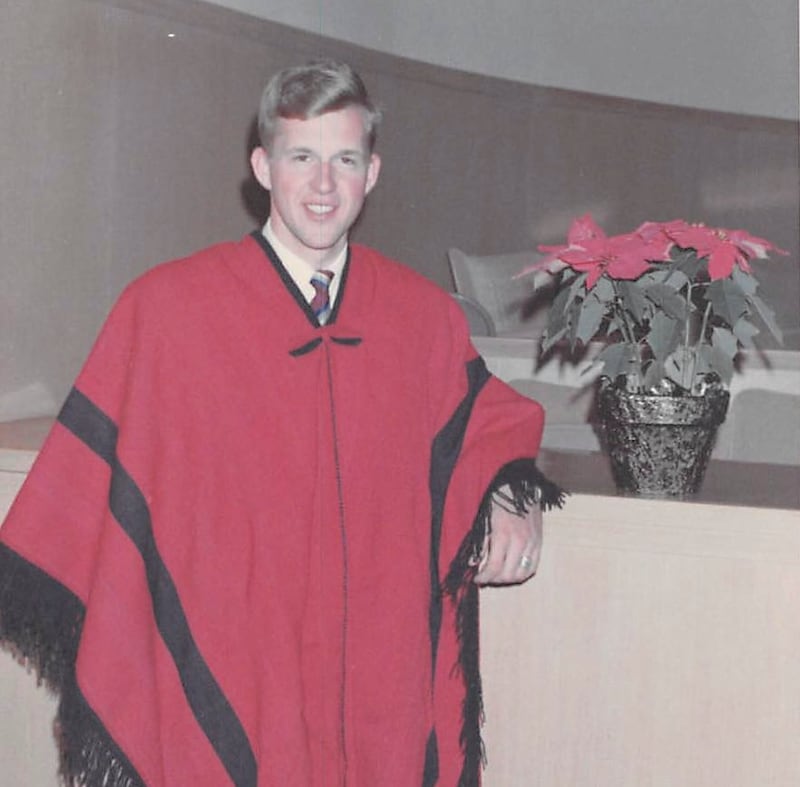
And in those days, the application was — everything was paper, obviously. We would send the application, all the medical report and so forth, to Salt Lake, and it took a while. You did not expect to have any answers before two, three weeks later. So everyone was on pins and needles. And then when it came, we opened it and read it. There was no big ceremony, not really much of an event at the time, but I was thrilled to receive the call. I had no familiarity, no background, with South America and Argentina in particular, but I had studied Spanish in high school, and I was anxious to serve in a Spanish-speaking country, or delighted with the possibility.
And then, this is still true, but you need to send a letter back to the President of the Church, accepting a call. And to me, it was quite a sacred thing to respond to President David O. McKay that I would serve the mission, and I felt a great obligation there, a real sense of responsibility to be a good missionary. I was being called by the President, I was responding to him, someone I deeply admired, President McKay. And so it was not a big event, but it was a significant event for me.
5:58
Scott Taylor: Coincidentally today, before you joined us for this interview, you were assigning newly called missionaries — called by the Prophet, called by the First Presidency, but it’s the Quorum of the Twelve who makes the assignments for their field of service.
Elder D. Todd Christofferson: Right.
Scott Taylor: Can you talk about the differences in your start of your mission compared to what is typical for today? You’ve already spoken about receiving the call by paper, by mail, instead of digitally today. But these newly called missionaries that you’ve identified, you’ve assigned today — the young men, the young women, young elders, young sisters — will be having at-home, online training experience for a week, and then in a missionary training center for at least two weeks, or longer if they’re learning a language. What was the mission start like for you, or the training? And then talk about arriving in Argentina.
6:54
Elder D. Todd Christofferson: Well, as you say, today, it is quite — well, it is all computerized, in the sense that the call comes online, the application comes in online, the call is received online. The assignment is computerized. I sit with an assistant from the Missionary Department, who runs the equipment, and we pull up in sequence the name, the picture, the information about each missionary candidate, and then on a separate screen are all the missions of the Church around the world.
And the impressions come. It is a testimony to me every time that the Lord knows each of these people. Whether it is a couple or an individual or a service missionary, the Lord knows each one of them perfectly well. He knows what He wants for them, what they need and what they can do, where they will serve and bless particular individuals or the most people possible. And the paperwork is prepared. The notice, I should say, is prepared. With the call from the President of the Church, there is sent out information about the mission. But while it is fully electronic, in a sense, it is still very much a spiritual work and a spiritual experience to be a part of it. I hope and trust that is true for the missionary. I know it is true for me and the assignment process.
8:39
When I got the assignment to the mission, there were two missions in Argentina then, north and south. North was Córdoba, south was Buenos Aires. The north mission was only two or three years old at that point. And I received the packet of information about the mission and what I needed to buy in the way of clothes and anything else, and then arrived at the mission home. There used to be a building here, and it was a transformed or remodeled home that sat on the block where the Conference Center is now. And all missionaries in the U.S., at least, would come for a week, almost a week, to the mission home. And those who had not been endowed would go to the Salt Lake Temple. We would have visiting general authorities walk a block from the Church Administration Building to speak to us. Some basic training information, if you will. It did not matter which mission you were going to, it was a generalized orientation.

And then we came to this building, the Church Administration building, to be set apart as missionaries by a general authority. I remember Antoine R. Ivins was the one who set me apart. He learned, of course, that I was going to a mission in Argentina. He spoke Spanish. He showed me a book with some Spanish in it and asked me, do I understand that. I did not. I was a little discouraged at that point that I did not immediately grasp everything that was before me in Spanish, where I thought I had known it fairly well.
Anyway, that was the initial experience. And then at that point, those of us who were going to Spanish-speaking missions got on a bus and went to Provo, and there started the language training and mission experience, three months. There was also, I think at the time, Portuguese and maybe German there, but most of it was Spanish training. And after that three months, we would spend two years in the mission. So it was a 2 ¼-year mission, technically. And it was language training, language learning, in Spanish.
11:02
We were overcrowded at the time. There was no MTC, missionary training center, building or buildings set up at that point. But it was — I remember having a devotional or two there. I remember President Hinckley, Elder Hinckley, coming to speak to us. And he said, “You are not much to look at, but you are the best the Lord has,” in his typical, humorous way. I hope it was humorous. But it was a great experience. I really thrived on the chance to be in that environment and to be learning the language. And then we flew to New York, got our visas there at the consulate, and then had about a 24-hour winding trip down to South America, stops in Miami and Panama City and Lima, Antofagasta and Santiago, and finally Mendoza before we ever got to Córdoba. So we were dead tired at that point. And they wanted to feed us great Argentine beef, but we were not in a condition to appreciate it.
But that was the experience. I was arriving in December 1964. It seems so odd to be celebrating Christmas two weeks later in the hot summer. And they typically did it with fireworks. But that was the beginning. I found that I really did not understand spoken Spanish from native speakers. It was difficult for about six months, I would say, till I felt like I had some fluency. But that is true of missionaries generally, I believe, and I was not as far along as I thought. So it was humbling to get started in the mission, learning to speak and learning the culture and all the rest. But people were so friendly and welcoming, particularly members of the Church, that despite all that, I felt at home and happy to be where I was.
13:17
Scott Taylor: Where were some of the areas in northern Argentina that you served? Tell us a bit about where you served and maybe a memorable experience or two from your mission time.
Elder D. Todd Christofferson: The Argentina North Mission was about half the country. I don’t recall how many provinces were part of that mission at the time, but it was several, obviously. I began, the mission headquarters was in the province of Córdoba, in the city of Córdoba. But after the first few days of arrival and a little bit of orientation by the mission president — who was Ronald V. Stone, still living, the son of O. Leslie Stone, who was a former general authority — but I was sent right away to the smallest province in the country, which is Tucumán, sugar cane-producing area. The place is very fond, again, for me in my memory.
I ended up serving in Tucumán and Salta and Corrientes and back in Córdoba, the province of Córdoba, as well as the city, and the mission home for a while. And then Santa Fe was my last area, which is now a mission. It has a temple announced, if I am remembering right, Santa Fe in Rosario. And that is the last temple that was announced in April. Rosario was one of those, so it was in that province where I ended my mission.
14:50
Scott Taylor: You served in Córdoba, in a mission home, with your second mission president. Went from President Stone to President Richard G. Scott. What do you remember about those experiences?
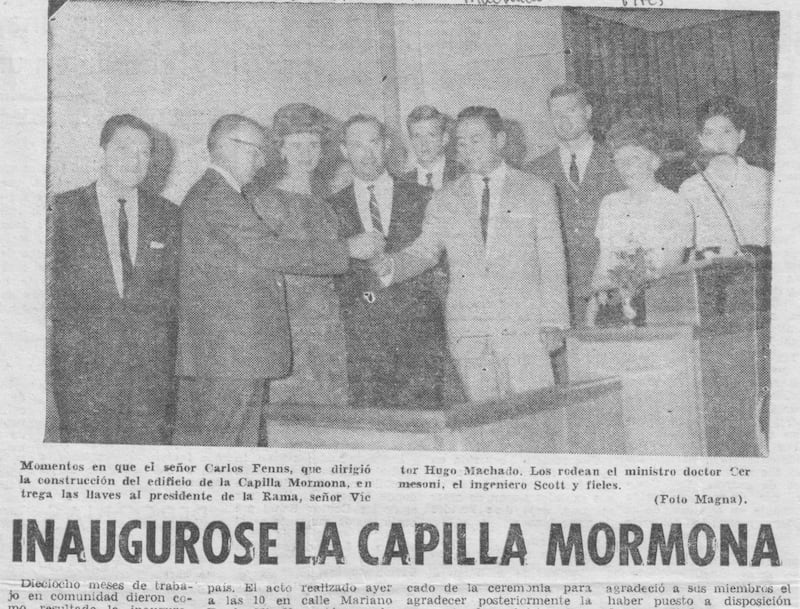
15:05
Elder D. Todd Christofferson: Elder Scott arrived in the mission after I had been there about seven months. He was the new mission president, his wife, Jeanene. I did not appreciate then how young they were; they were both in their 30s. And I think at that age, you think anybody over 20 is getting on in years. But it was interesting. Our first meeting, I was in Corrientes, which is a good ways away from the mission headquarters. And it was several weeks, I think, after he got to the mission before I met him. And he was making the rounds of each of the branches. There were no wards or stakes, then; it was all branches and districts. So he had the responsibility for all the members, not just the missionaries, but all of the members. He was the ecclesiastical leader for all of the districts, of course, that were part of the mission. Corrientes and Resistencia were a district.
So, he finally made his way there. I think there were six of us working and living in Corrientes at the time. And he interviewed us one by one. And I still remember sitting with him. We had a house there that we used as our branch building section for the chapel, and we lived in the back, a separate building, a little dormitory building, I guess you could call it, in the rear of the property. But we sat on a little porch out in the front of the building. And a couple of — I don’t think they were rocking chairs, but it was like sitting on the porch, conversing, having a conversation. It was an interview more than a conversation. But that was the first time I ever had a chance to get acquainted with him or meet him.
And I look back on that, and I think, “Who would have ever guessed,” certainly not me, “that there were two future Apostles sitting down together, meeting for the first time?” One the president, one missionary, the beginning of a lifetime, almost of association, wonderful association and friendship. Nothing auspicious about the moment, nothing that would lead you to think something like that would come in the future.
17:24
Scott Taylor: And not only two Apostles, but two Apostles who served together. And we’ll talk about that in a moment. How did your testimony of the gospel and of the Savior Jesus Christ and of Heavenly Father, how did your mission help your testimony grow?
17:43
Elder D. Todd Christofferson: I believe that missions, automatically, if a person is involved in working and anxiously engaged, automatically produce a deeper testimony, it is just because that is the nature of what you are participating, the process, the activity, the service that you are a part of. I remember, for example, this is a small example but meaningful to me. I recall very vividly, still, early in my mission, teaching a family. I can envision in my mind the home and the room and so forth, even the name of the street, Roque Sáenz Peña, and I was teaching about the First Vision, the Prophet Joseph Smith’s First Vision, and relating what had happened. And they did not have a lot of interest, to be honest. And they never did progress very far with us, attend church or anything. But in that moment, as I was telling them something they were not receiving, there came to me a witness, very powerfully of the Spirit, of my own words. “What you are saying is true.” A testimony of my testimony, if you will, as I was bearing it.
And that has happened more than once. I mean, that is a confirmation, a wonderful spiritual confirmation, of the testimonies we bear, the things we teach, the gospel itself. A lot of it is in the associations. You see wonderful examples in companions and mission leaders and members of the Church and people here and there that you cross paths with in the mission who have a deep covenantal commitment to the Lord, and it rubs off on you. Hopefully you are a good influence on others, but others on you.
And my study of the Book of Mormon. I had read the Book of Mormon a couple of times. I think by the time I went on a mission, it was the foundation of my testimony, my witness of the Savior. But reading it in Spanish opens some new understanding, insights, that come when you are reading in a different language, just the way the words are phrased or the words that are used that strike a chord, or a light comes on, and you have an added understanding that is very helpful in the witness you have, in fortifying and sustaining the witness that you already have.

20:31
So those are, I think, just examples of the kind of things that happen in due course, in the normal course, of missionary work. The zone conferences we had were really wonderful. I remember a couple specifically, next to the mission home in Córdoba. We had a chapel there. It is now gone. It is part of the buildings that are the temple block. But I still see that again in my mind’s eye. And it is interesting that at that time, all of our zone meetings were conducted in English. Almost all the missionaries were North Americans. We had a few native Argentinians who were serving, maybe one or two from other countries, I don’t recall, but the mission language in our training was basically English. Today, it is just the reverse. There are some North Americans and others, but the majority, I think, are from Argentina and other Latin countries.
But those were wonderful experiences, just drinking in the Spirit, learning from each other. The association with each other, the instruction from the mission president, his wife, and just to have a closer association with them, with Elder and Sister Scott, were fortifying, spiritually and otherwise.
21:56
Scott Taylor: Two years in Argentina as a missionary. Now we’re going to fast forward through return to BYU, through meeting and dating and marrying Kathy Jacob, law degree, clerking, legal profession, call as a general authority and a member of the Presidency of the Seventy, in 2008 you’re called as an Apostle of the Lord Jesus Christ, as a member of the Quorum of the Twelve Apostles. And we’ve already mentioned it: One of those quorum members was your mission president, Elder Scott. What was it like to have that first interaction, that first conversation as Apostles? I mean, you’d had interactions with him as a general authority before, but here is a special call shared and a return to a brotherhood and a mentorship.
22:47
Elder D. Todd Christofferson: Well, I was fortunate when Kathy and I moved to the Washington D.C. area to begin my professional career following law school. My first job was as law clerk with Judge John Sirica in Washington, D.C. So we moved from Durham, North Carolina, to Washington. Elder Scott was living there at that time, he and his wife. Their children were grown, they did not have any at home anymore, but they lived in the Washington D.C. Stake, and we were part of that same stake. And he was a counselor in the stake presidency. So we had interaction there.
We lived in that area from 1972 to 1980. And I believe he had been called by them as a general authority, but we had a good interaction together. I remember once visiting their home when he was speaking to another of his former missionaries, who had just been called as a bishop, and giving him some training. And he said, “Come over, and I will train you too.” And I later was a bishop, but not at that time. That was his trademark, I think. He was always training, counseling, offering help to people. As I go across Latin America, his footprints are everywhere. And it seems like everyone has a story about some personal interaction with him where he taught them this or taught them that. And I think, “How did he reach millions of people one by one?” He just was always intent on sharing what he had to share, and he was that way with me when we lived together there in the metropolitan area, D.C.
I remember taking our third son, who had just been born there, over to their home. Before we even went home, we went from the hospital to their home in Bethesda and then to our home in Rockville, but I said, “You have got to meet our latest baby.” So we had a wonderful camaraderie and easy, relaxed kind of association. Then he was called as a general authority. We did not have any, really, much contact, if any, till I became a general authority, and then he was so welcoming and, again, wanting to add aid and help in any way he could. Very kind, really.
25:20
We only got a few assignments together while he was in the Twelve and I was in the Seventy. We don’t control that, but I always regretted we did not have more assignments with one another. But he was helpful as I prepared a conference talk and even sent me one or two of his to see if I had any comments about his, and so on.
I remember the Brethren offered us the chance to study here a couple times a week with an MTC instructor a different language, if we wanted to learn another language. So I thought I would learn French — I had always loved that language — and signed up for that and then encountered Elder Scott in the hallway. And he said, “What are you studying?” I said, “French.” He said, “No, you are not. You are going to study Portuguese, because between English, Portuguese and Spanish, you cover 88% of the Church.” So you have got to be obedient to your mission president, and I dropped the French and picked up the Portuguese. Still trying to learn it. If I could live in Brazil for a year or two, I might really have it. But that is just an indication of an easygoing relationship and his always sound advice.

When I came into the Quorum of the Twelve in 2008, he was — I don’t know what his seniority was in the quorum, the first half of the quorum. When I had become a Seventy, he was the junior member. And he was somewhere in the middle when I came into the quorum. And we had a wonderful relationship there. I sometimes half-jokingly wonder what he thought, because mission presidents know all the weaknesses and the faults and failings of their missionaries. But missionaries don’t know any of their presidents; they are perfect. And I always wonder what went through his mind sometimes, knowing how imperfect I am, but he was extremely supportive always, of course, and shared things.
27:31
He shared, for example, that he had been in a remote area of Brazil not long before he was talking to me. And I think he shared this with others as well, but he said, “I was handed a note at the end of a devotional by a sister who had come from some distance to be there. And the essence of the note was, ‘I came all this distance to hear the testimony of an Apostle and did not receive it,’” and she was expressing her disappointment. So I do not know if it had not been something the way she expected it to be, or if he had passed over lightly or something.
But she was disappointed. That hurt him to the core. And he was starting with me just to say, “Don’t ever let an opportunity pass, especially as you are out among the members of the Church, that you don’t bear a clear and sure witness of the Savior.” And he said that “I have made that commitment to myself that this would never happen again.” I took that to heart. It was kind of him to share that. It was not something you would typically want to broadcast or have other people be aware of or know, but he was willing to, well, he was humble enough to share something like that that was difficult.
Scott Taylor: To open himself up that way.
29:08
Elder D. Todd Christofferson: Open himself up, yeah. He was always very good on object lessons, too. He had that scientific background as a nuclear engineer. He was a master teacher. He just constantly taught me. That was his, as I said, his trademark, constantly teaching. And it is a sweet thing just to look over, see your former mission president sitting in the quorum, and I hope he felt the same. I think he did. And I was able to be with him with Elder Nelson, now President Russell M. Nelson, and I went to his home the day he died and gave him a blessing. I assumed Elder Nelson would give him the blessing, but he asked me to do it because of that relationship, I am sure. And then he passed away a few hours later.
30:00
Scott Taylor: So, the Salta temple dedication that is coming up will be your third involvement in temple dedication or rededication in that near-and-dear-to-your-heart country of Argentina. Just briefly, what do you remember about 2012, going for the rededication of the Buenos Aires temple? That’s in the country but not part of your mission.
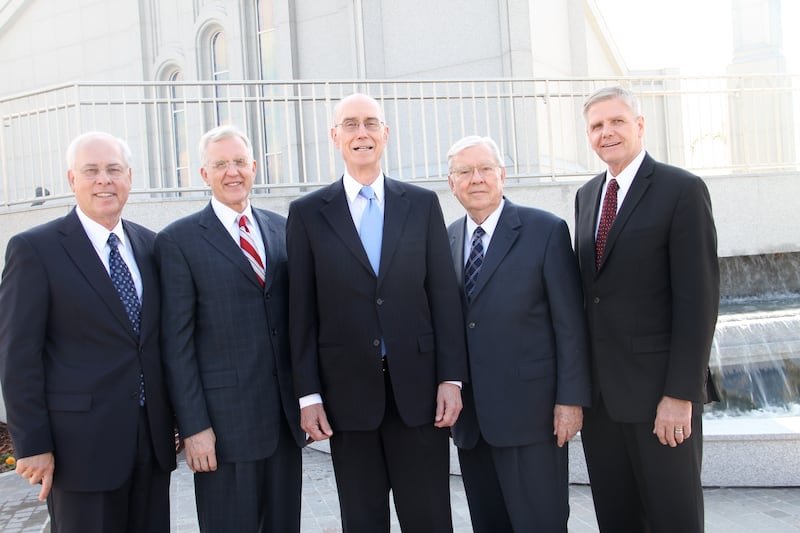
30:28
Elder D. Todd Christofferson: It was interesting; after returning from the mission, I had never been back to Argentina or anywhere in South America for 38 years. I came home, as you say, went to school, married, had a family, had my career in law and never had occasion at all to go back there. And even after becoming a general authority, for quite a while. My first return trip was with Elder Russell M. Nelson, now President Russell M. Nelson, for a multistake conference in Buenos Aires, and it was a thrill. It was all coming back.
We even crossed paths — the woman that was translating for my wife in that conference was a little girl when I knocked on her family’s door and taught them the gospel in Córdoba. She now lived in Buenos Aires. And it is Renee Costa; Elder Joaquin E. Costa of the Seventy is her husband now. He was not in the general authority ranks at that time, but he later was called. So, Renee Costa was our translator, her translator. So it was wonderful to begin to see other parts of the country, but also, most important, to renew acquaintances and live vicariously some experiences again that had happened while I was there as a missionary.
For the rededication of the Buenos Aires temple, I was with President Henry B. Eyring. He was a counselor in the First Presidency, as he is now, and had that assignment. I had never been in that temple before. I think I had seen it once on the road from the airport in a prior trip. But it had been remodeled and expanded a bit, and it was wonderful to see it and to spend the time there. We were also accompanied by Elder M. Russell Ballard. He was not yet president of the Quorum of the Twelve, but he was in the Twelve. And his great-great-grandfather, of course, was the one who had dedicated the continent for the preaching of the gospel. And I was privileged to read the dedicatory prayer at least in two of the sessions. I think it was three sessions. And it was something I never would have dreamed of. I always hoped there would be other temples but never envisioned it, I guess.
33:08
Scott Taylor: And then yet, three years later, you’re participating in the dedication of the Córdoba temple, which is right next to your mission home. And you talked about the temple grounds. How meaningful was that?
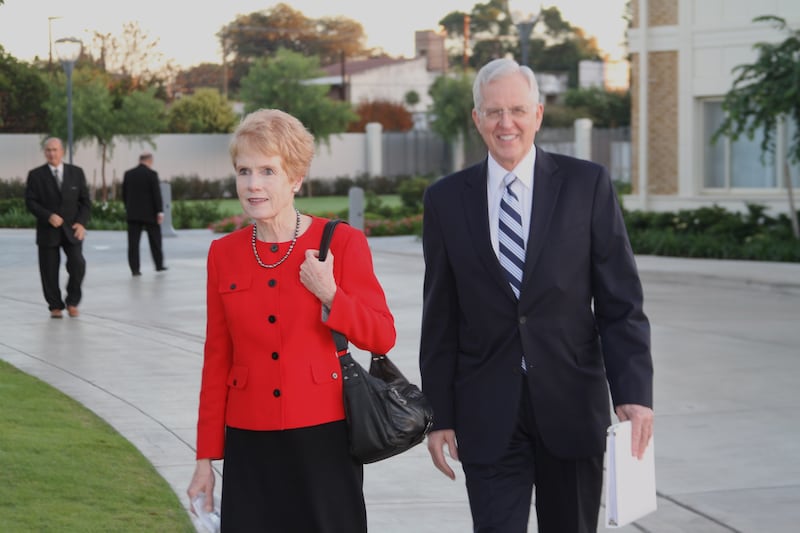
33:24
Elder D. Todd Christofferson: Very meaningful. President Dieter F. Uchtdorf was the one assigned, as a member of the First Presidency at the time, to dedicate that temple. It is just a beautiful temple. It is right on the grounds where the mission home and mission office were and now are again; I guess it never stopped being that. It was a combined home and office, so the president’s family lived in one section, the mission offices were in another.
And the time I worked in the mission home, mission office, that is how it was, and that is how it is today. It was torn down and restructured, reconstructed. But it is still the same format. Interestingly, that is pretty rare. And it is still there. It is fenced just outside the temple proper. But it is the same location. And to see that again, to visit some of the missionaries there, it was very special. They had no idea about my background in that same spot of earth. But it was just fun to be there again.
I went there later, some years ago after the dedication, and the temple president was a man who had been a young man in Santa Fe when I was a missionary there. He was a teenager, and he had gone out with us from time to time on missionary splits to visit and teach, and now he was there as the temple president. That was quite a reunion. This is after, a few years after the dedication.
35:18
Scott Taylor: Wow, all of these connections and crossovers and reconnections. And that leads us now to Salta — dedication in 2024, an area where you served. We have a picture of you there with your companion in one of the main plazas. What does it mean to go back to Salta now to dedicate a third temple, third house of the Lord in that area?
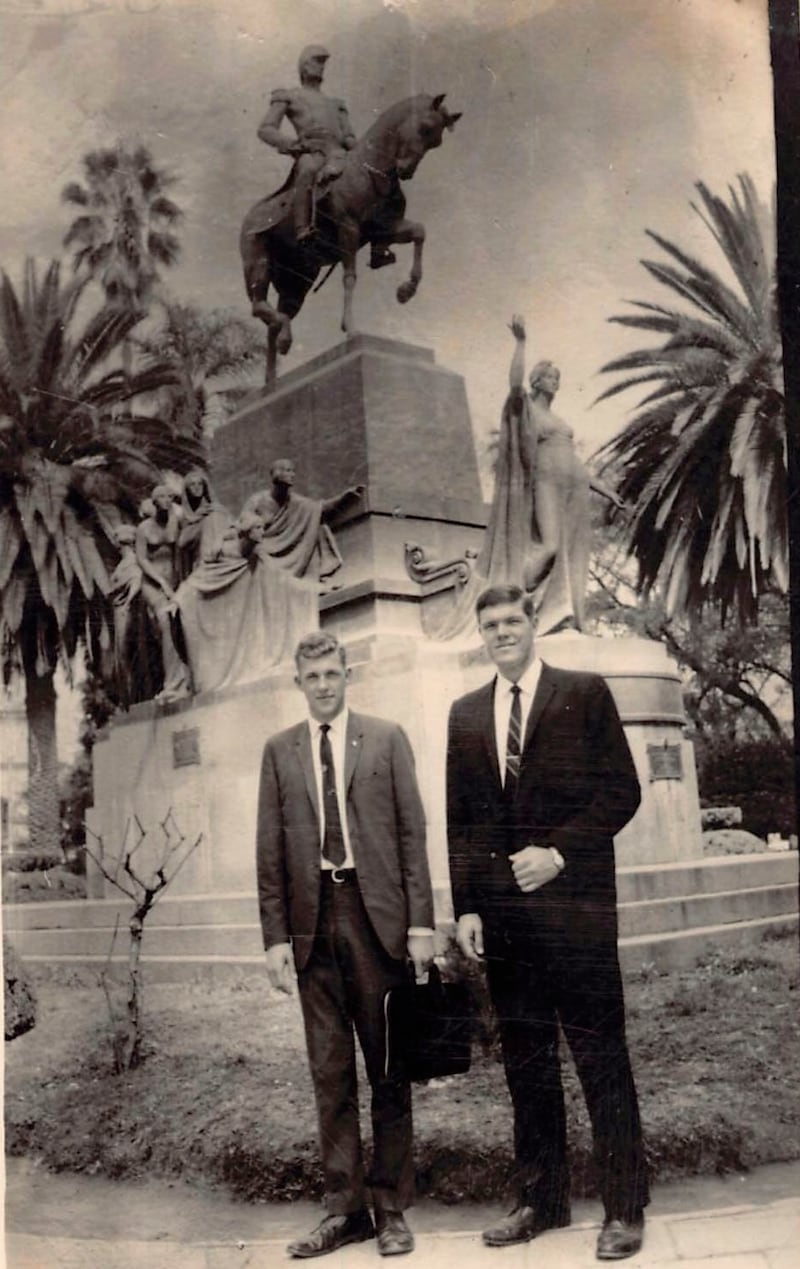
35:42
Elder D. Todd Christofferson: This is the first one that I will dedicate, had been assigned to dedicate. I was part of the earlier dedications for Buenos Aires and Córdoba, and I will always remember those experiences. And this is a little unique in having the assignment to be the one to pronounce the dedicatory prayer there. I would never have guessed, frankly, that that would happen in my lifetime. Salta was the second area I served in. We had, I think, two branches at the time. There were no chapels or buildings of our own construction. And now, a temple.
I remember helping a member — there were eight missionaries there — and one preparation-day morning, we went to this member’s home. He was fairly poor. His family lived in a small one-room house on the street, with a long lot behind. And he wanted to move his house back so he could put a little store in the front by the street and get a little added income. And he had laid a cement footing, or floor, back where he wanted to put the house, and the eight missionaries, with his direction, took apart the whole home, adobe bricks, just took them all apart, cleaned them off, carded them back to this new location. He had a combination of mud, mortar or something he prepared. And so he was laying the bricks as we brought them back. And by the end of the day, and with a little light bulb dangling down in the middle, he had his house in a new place.
Those are wonderful and unique memories that stay with me. And we got very close to the members there. And that is where I really felt like I was a capable teacher, having really now some fluency in the language. We, during our P-days at other times, we helped build the first chapel. There was a chapel of ours under construction during the time I was there. And they don’t do this now, but we were volunteer laborers during various days and different times to build that, and it is still standing. It had a fire that partially destroyed it, and they had to rebuild, but it is still standing there.
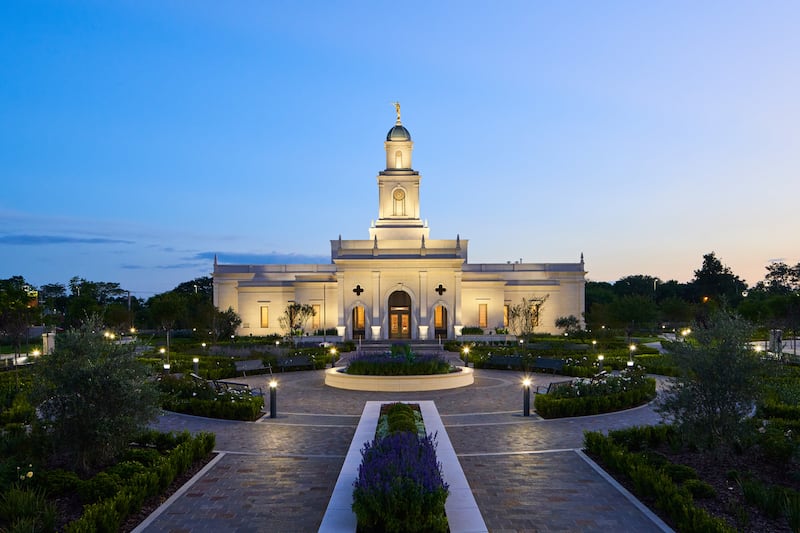
And so, that was — I thought when I left, “I have done something worthwhile and probably will never see this place again.” But that was a maturing and a really rich experience for me. Now, I think of coming back these years later, having been at the dedication of the first chapel, now to be there for the dedication of the temple. As I say, I wish I had greater faith and foresight to have seen that moment back in those days, but what a wonderful thing to live long enough to see that transition and the progress of the Lord’s kingdom, all day-to-day invisible to us. I mean, we don’t see what is happening, but looking back see a tremendous miracle has occurred. And it just says to me, again, it is the Lord’s work. He is making it happen. He is doing the work for the most part. We get to help around the edges.
39:10
Scott Taylor: You talked about not having that foresight, and it leads into my concluding question. Sarah Jane Weaver, who normally hosts the podcast, always has this question: What do you know now? I’m going to ask you to speak to that. And so the question I would pose to you, with a little twist on that: What do you know now after a lifetime of family, profession, the Church service and as an Apostle of the Lord Jesus Christ, what do you know now that if you could go back and tell Elder D. Todd Christofferson, the full-time missionary in the Argentina North Mission, what would you tell yourself?
39:50
Elder D. Todd Christofferson: One thing I would say is don’t ever be discouraged. You don’t see things unfolding that are unfolding. You don’t see what the Lord is putting in place. And the people, the key people and the key moments that are happening, you are not cognizant of all of that going on in the moment. And I don’t blame myself or anybody else for that. I mean, we are human, we are mortal, and we have a limited perspective. But we ought to have the faith; I would say to myself, “Have the faith that the Lord is doing His work and can do His work, and that your part of it can be helpful, can be meaningful, and more will come of what you are doing than you perhaps imagine, or certainly more than you can see right now.”
So, be of good cheer. Go about the work and don’t worry about this or that that did not happen the way you hoped, or someone who you loved and wanted to see come into the Church did not; maybe they did later, or maybe other things transpired that they touched someone else. And you just never know how it is going to unfold and what is going to be the result of what you are doing in the moment today.

We really can enjoy the work. And that is what I would say: Enjoy this privilege, this work. It will have satisfaction well beyond anything you can imagine, in big ways and small ways. I remember meeting one of those I helped baptize years ago, and she had a daughter, now 10 years old, and introduced me: “This is the missionary that brought us the gospel in Argentina.” And this little sweet, brown-eyed girl looks up and said, “Thank you.” And I thought, “My whole mission is worth it just for that expression of gratitude from a girl that was not even alive, here in mortality, at the time.”
So I would say have faith. Think of people in a way beyond the moment so that you do envision what can be in their lives. I think that was a strength of President Scott, Elder Scott; he saw what could be in people and helped them move in that direction. So I would say to myself, “You are helping everybody move another step or two or three. Enjoy that, have satisfaction in it, but have the faith to have a broader view that what is a little branch today will be a ward and then a stake and that there will be a temple here. Things are going to happen even while you are still alive, let alone what comes afterwards. So enjoy it. Have faith and enjoy it.”
42:49
Scott Taylor: And watch what happens. Would you do the honor for us of concluding with your brief testimony? Y quizás una parte en español. (Perhaps a part of it in Spanish.) I don’t know if we’ve done that on the podcast, but it’d be very appropriate here.
43:05
Elder D. Todd Christofferson: Maybe we can do it both ways. I mentioned earlier that my experience as a teenager in New Jersey and in the mission and in many other settings since, I have strengthened my faith in Christ, my faith in God, basically being able to see some of what they are doing and recognize that it is Their hand in my life and in much broader activity. But I think my testimony is much like many others, that it would be hard to point to a moment when you say, “I did not have one, and now I do.” I can think of special moments where it was a strong, powerful reinforcement of things that I already knew, really, but it has come gradually. It has come over time.
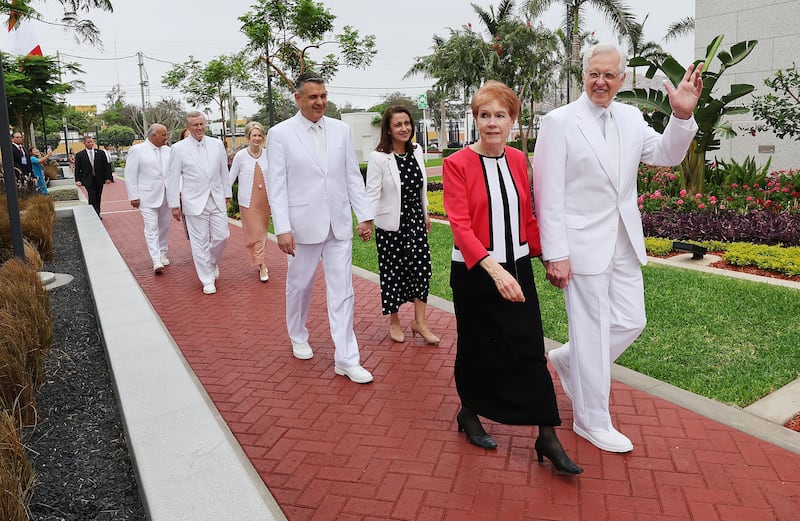
For me, the Book of Mormon has been a key. It is a testimony of Jesus Christ. It is for me the most powerful written witness of Him in existence. And the more I study it, the deeper my own understanding and conviction grows.
I think of Peter assembling the church soon after the Savior’s Ascension and saying, “We need to replace Judas Iscariot in the Quorum of the Twelve Apostles. And the way he phrases it in Acts, Chapter 1, at the end there, is we have to select one of these men who has been with us through the Savior’s ministry who will be with us a witness of His Resurrection. And that was the main focus, the witness of the Resurrection of Christ. Why so important? That is the proof. That is the proof of the truth of everything we are teaching in the gospel of Jesus Christ, the proof that He can keep His promises, He has power to and He is willing to, that He is God, that He has that power to take life again. It is just that seal of authenticity and truth on everything related to the gospel of Jesus Christ and the plan of happiness, that immortality and eternal life are now realities because of His Resurrection. That is the confirmation.
45:45
And so I rejoice, really, in the opportunity — anytime, anywhere — to bear witness of His Resurrection, as a witness of His name, meaning that He has that power, that He has that authority and that He has the grace or the atoning grace to be able to cleanse us, to sanctify us, to bring us immortality, to do everything necessary to realize the ultimate outcomes of the gospel of Jesus Christ. He lives. He has that power. He is exercising it, He is directing. The Church is His instrument to accomplish these things in this last dispensation. It is such a thrill, really.
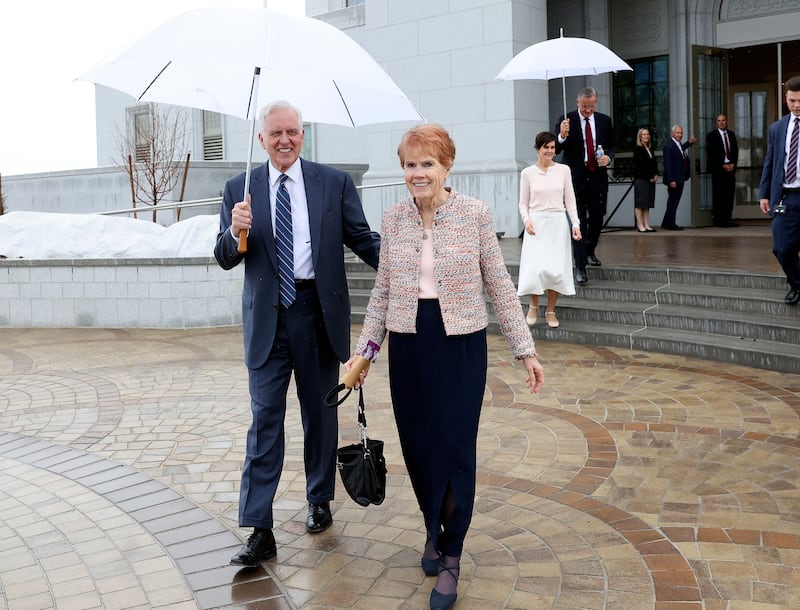
I rejoice so much just to be able to say it, that I know He is the Christ, He is the living Christ, He is the resurrected Christ, and we are His sheep. We have taken upon us His name, and in the last day, He will own us, and we will eternally be together. And I add that witness in the name of Jesus Christ, amen.
47:07
Mi experiencia, a lo largo de mi vida, mis experiencias me han enseñado la realidad de Jesucristo, la realidad de nuestro Padre Celestial, que Ellos viven, que somos hijos de Dios y que han establecido un plan de redención, un plan de salvación y de exaltación. Y que la obra de Ellos es llevar a cabo la inmortalidad y la vida eterna del hombre, y lo hacen, pueden hacerlo, tienen el poder para hacerlo. Y esa es la gran realidad de nuestra existencia realmente.
[My experience, throughout my life, my experiences have taught me the reality of Jesus Christ, the reality of our Heavenly Father, that They live, that we are children of God and that They have established a plan of redemption, a plan of salvation and of exaltation. And Their work is to bring about the immortality and eternal life of man, and They do it, They can do it, They have the power to do it. And that is really the great reality of our existence.]
47:55
Yo, al pensarlo, me doy cuenta que mi testimonio de estas verdades viene o se profundiza y crece en mi estudio del Libro de Mormón. El Libro de Mormón forma la base de este testimonio porque es el testimonio por escrito más poderoso, más potente que existe en el mundo por escrito.
[As I think about it, I realize that my testimony of these truths come from or deepen and grow in my study of the Book of Mormon. The Book of Mormon forms the basis of this testimony because it is the most powerful written testimony that exists in the world.]
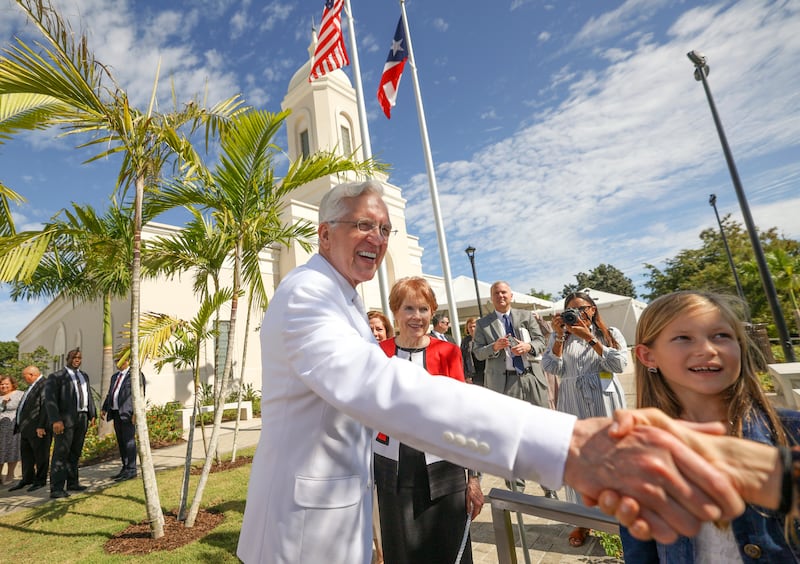
48:29
Y el propósito del libro, al fin, es dar testimonio de Jesucristo, que realmente es el Hijo de Dios y nuestro Redentor, nuestro Salvador. Y yo regocijo en el privilegio de poder dar testimonio de Él que he recibido a través de mi estudio del Libro de Mormón, de las demás escrituras, la Biblia, etcétera; de mis oraciones; de mis experiencias; sobre todo por el Espíritu Santo, que es el testigo, Él que da testimonio del Padre y del Hijo.
[And the purpose of the book, ultimately, is to bear witness to Jesus Christ, who really is the Son of God and our Redeemer, our Savior. And I rejoice in the privilege of bearing witness of Him that I have received through my study of the Book of Mormon, the other scriptures, the Bible, etc.; from my prayers; from my experiences; above all through the Holy Spirit, who is the witness, the One who bears witness of the Father and the Son.]
49:14
Yo recuerdo que en la época del ministerio mortal de nuestro Señor, después de haber sufrido su muerte en la cruz, efectuado la Expiación de nuestros pecados, etcétera, ascendió al cielo, dejó a los apóstoles, Pedro y los apóstoles, para dirigir la iglesia y su obra en la tierra.
[I remember that at the time of our Lord’s mortal ministry, after having suffered His death on the cross, He brought to pass the Atonement for our sins, etc., He ascended to heaven, left the apostles, Peter and the apostles, to lead the church and His work on earth.]
49:48
Y en el momento que los miembros de la iglesia se reunieron después de la Ascensión del Salvador, Pedro dijo, “Tenemos que escoger otro miembro de este Quórum de Doce Apóstoles para sustituirlo, reemplazar,” y dice, “sustituir el apóstol que traicionó el Salvador: Judás.” Y dijo en ese momento, “Tenemos que tener otro más que pueda dar testimonio de la Resurrección de Jesucristo con nosotros.”
[And at the time that the members of the church gathered together after the Ascension of the Savior, Peter said, “We must choose another member of this Quorum of Twelve Apostles to replace Him,” and he said, “replace the apostle who betrayed the Savior: Judas.” And he said at that moment, “We have to have another one who can bear witness to the Resurrection of Jesus Christ with us.”]
50:34
La importancia de la Resurrección es la prueba de todo. Eso es lo que confirma que es el Hijo de Dios, que Él puede cumplir Sus promesas, tiene el poder, ha vencido todo, hasta la muerte, y ha descendido por debajo de todo y ascendido sobre todo y posee todo el poder en la tierra y en el cielo, y la prueba de ello es la Resurrección de Él.
[The importance of the Resurrection is the proof of everything. That is what confirms that He is the Son of God, that He can keep His promises, has the power, has overcome everything, even death, and has descended below everything and ascended above everything and possesses all power on earth and in heaven, and the proof of this is His Resurrection.]
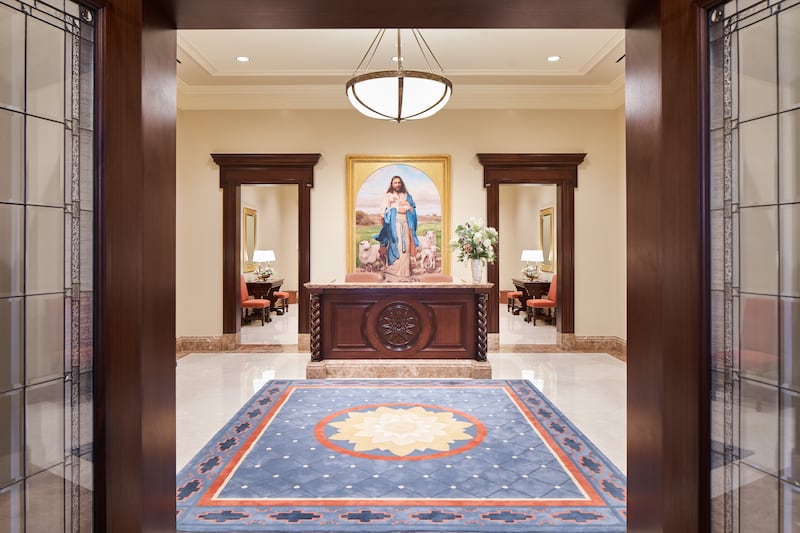
51:07
Así que con todo gusto, con mucho amor y gozo, doy testimonio de la Resurrección de Jesucristo, que en verdad es el Redentor viviente. Vive hoy. Está dirigiendo La Iglesia de Jesucristo de los Santos de los Últimos Días. Es Su instrumento en este momento, en esta dispensación, para llevar a cabo los propósitos de Dios en la vida de Sus hijos. Y es la verdad. En verdad, es la verdad. Y yo doy este testimonio. Poseo este testimonio. Tengo esta certeza, y lo puedo expresar por El poder del Santo Espíritu en el nombre de Jesucristo, amén.
[So with great pleasure, with much love and joy, I bear witness to the Resurrection of Jesus Christ, who truly is the living Redeemer. He lives today. He is leading The Church of Jesus Christ of Latter-day Saints. It is His instrument at this moment, in this dispensation, to carry out the purposes of God in the lives of His children. And it is the truth. Truly, it is the truth. And I bear this testimony. I have this testimony. I have this certainty, and I can express it through the power of the Holy Spirit in the name of Jesus Christ, amen.]
51:54
Scott Taylor: Amén. Gracias and thank you, Elder Christofferson, for your time and joining us today.
52:09
Sarah Jane Weaver: You have been listening to the Church News podcast. I’m your host, Church News executive editor Sarah Jane Weaver. I hope you have learned something today about The Church of Jesus Christ of Latter-day Saints by peering with me through the Church News window. Please remember to subscribe, rate and review this podcast so it can be accessible to more people. And if you enjoyed the messages we shared today, please make sure you share the podcast with others. Thanks to our guests; my producer, KellieAnn Halvorsen; and others who make this podcast possible. Join us every week for a new episode. Find us on your favorite podcasting channels or with other news and updates on the Church on TheChurchNews.com.




